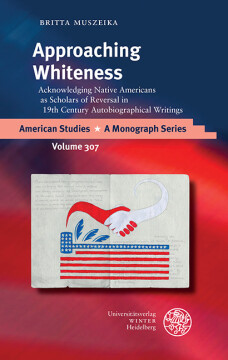
BUCH
Approaching Whiteness
Acknowledging Native Americans as Scholars of Reversal in 19th Century Autobiographical Writings
American Studies – A Monograph Series, Bd. 307
2020
Zusätzliche Informationen
Bibliografische Daten
Abstract
Since the 19th century indigenous writers have been challenging their missing cultural, political and literary invisibility. Yet, stereotypical misconceptions of “the inferior Indian” continue to exist. This “study of reversal” unfolds an unseen perspective of Native Americans in which they emerge as ethnographers of whiteness and indigeneity. Rereading the autobiographical accounts of Charles A. Eastman, Sarah Winnemucca and Zitkala-Ša results in a framework which allows us to reimagine native culture, while it simultaneously reverses and completes our understanding of white identity. This new approach investigates how these native writers create a counterimage of the “Indian’s White Man,” by creating their own study of “races.” By emerging as scholars of reversal ‘avant la lettre’, their works may additionally be read as testimonies of reconciliation.
Inhaltsverzeichnis
| Zwischenüberschrift | Seite | Aktion | Preis |
|---|---|---|---|
| Cover | Cover | ||
| Titel | III | ||
| Imprint | IV | ||
| Acknowledgments | VII | ||
| Abbreviations | IX | ||
| Table of Contents | XI | ||
| 1 Introduction | 1 | ||
| 1.1 “The White Man’s Indian” | 1 | ||
| 1.1.1 “The Indian and the White Other” | 5 | ||
| 1.1.2 Along the Stony Road towards Reconciliation | 8 | ||
| 1.1.3 Redefining a Myth – Embedding Reconciliation in Education | 19 | ||
| 1.2 Reversing the Gaze – “The Indian’s White Man” | 25 | ||
| 1.2.1 Indigenous Testimonies – On the Trails of the White Man | 28 | ||
| 1.3 Scholars of Reversal ‚avant la lettre‘ | 32 | ||
| 2 The Emergence of the Color White | 35 | ||
| 2.1 Historical Development – Creating a Myth | 35 | ||
| 2.2 The Invisible White Man | 43 | ||
| 2.3 Using White Ink – Native American Literary Transparency | 56 | ||
| 2.3.1 Authentic Voices – the Writing “Indians” | 62 | ||
| 3 Theoretical Framework – Critical Race Theory (Tribal Critical Race Theory) and Whiteness Studies | 71 | ||
| 3.1 Understanding Race – Manifold Perspectives | 74 | ||
| 3.2 Resisting the Cliché | 81 | ||
| 4 The Voice of Color | 97 | ||
| 4.1 A Rereading of Sarah Winnemucca's ‚Life Among the Piutes: Their Wrongs and Claims‘ (1883) | 97 | ||
| 4.1.1 “My White Brothers Have Come at Last!” | 104 | ||
| 4.1.2 Approaching and Understanding White Culture | 111 | ||
| 4.1.3 Collecting Experiences – Encountering the White Man | 117 | ||
| 4.1.4 Winnemucca and the Indian Agents | 134 | ||
| 4.1.5 Winnemucca and the Military | 143 | ||
| 4.2 A Rereading of Zitkala- Ša’s ‚American Indian Stories‘ (1921) | 152 | ||
| 4.2.1 Native American Residential Boarding Schools | 154 | ||
| 4.2.2 Closing the Educational Gap | 159 | ||
| 4.2.3 Zitkala Ša’s Counterstory | 164 | ||
| 4.2.4 The White Man’s Land of Milk and Honey | 176 | ||
| 4.3 A Rereading of Charles Alexander Eastman's ‚Indian Boyhood‘ (1902) ‚and From the Deep Woods to Civilization‘ (1916) | 221 | ||
| 4.3.1 Into the Woods – Discovering Native American Territory | 225 | ||
| 4.3.2 The Mysterious “Pale-Faces” | 230 | ||
| 4.3.3 Towards Civilization – Embracing White Culture | 239 | ||
| 5 Conclusion | 257 | ||
| 6 Works Cited | 265 | ||
| 6.1 Primary Sources | 265 | ||
| 6.2 Secondary Sources | 269 | ||
| German summary / Deutsche Zusammenfassung | 291 | ||
| Academic resume / Akademischer Lebenslauf | 293 | ||
| Backcover | 294 |


 Publishing Platform by CloudPublish
Publishing Platform by CloudPublish